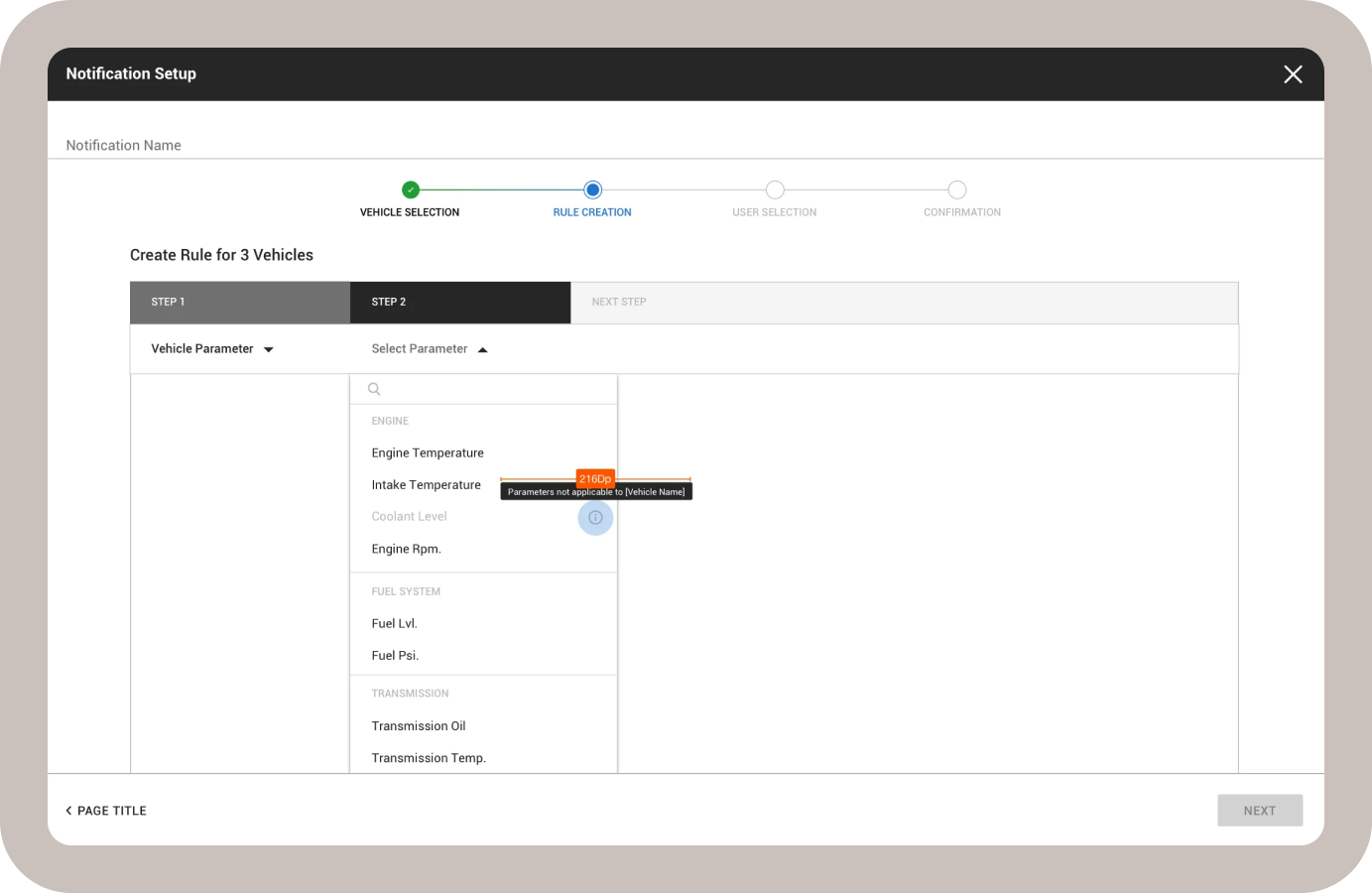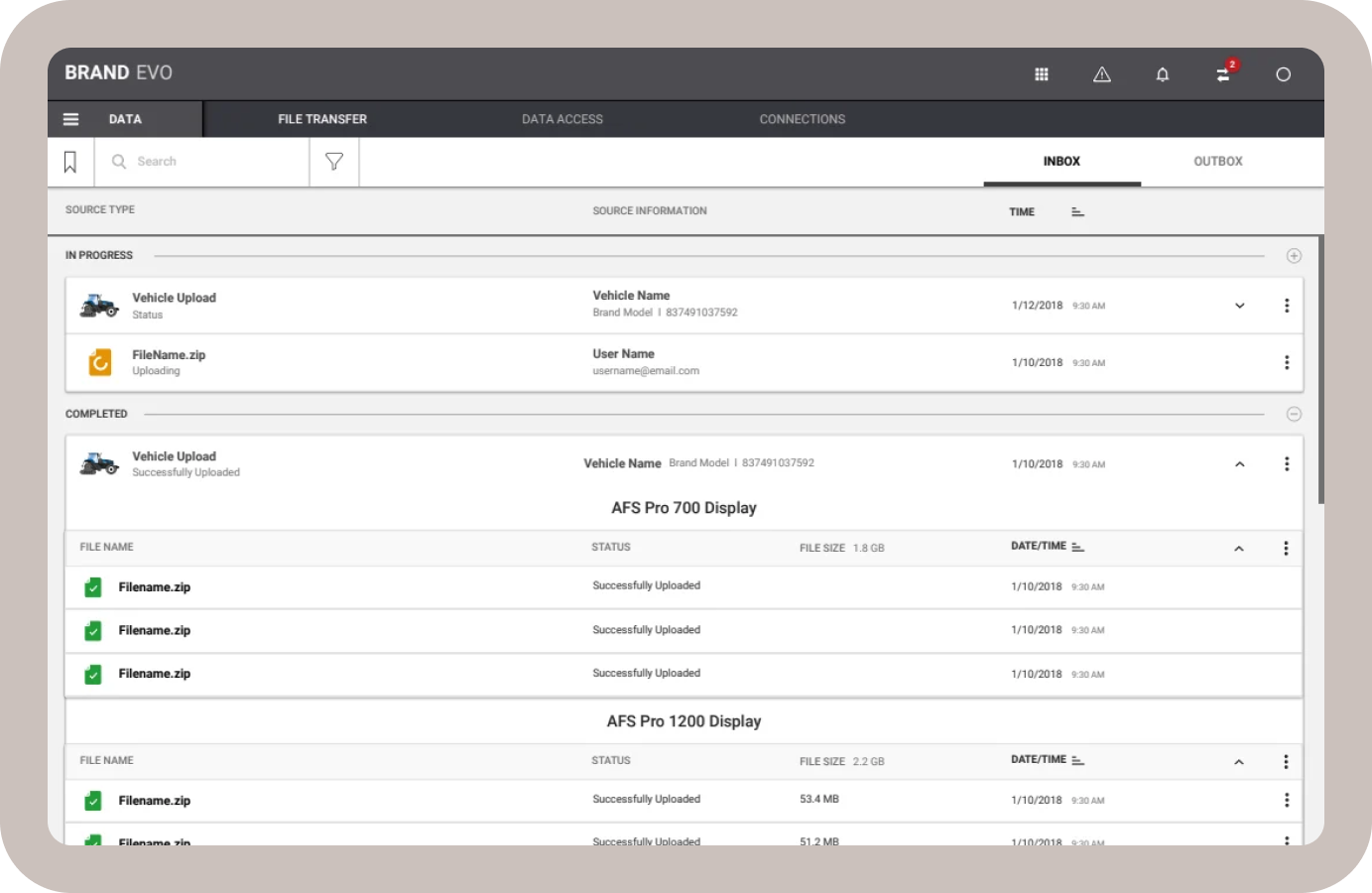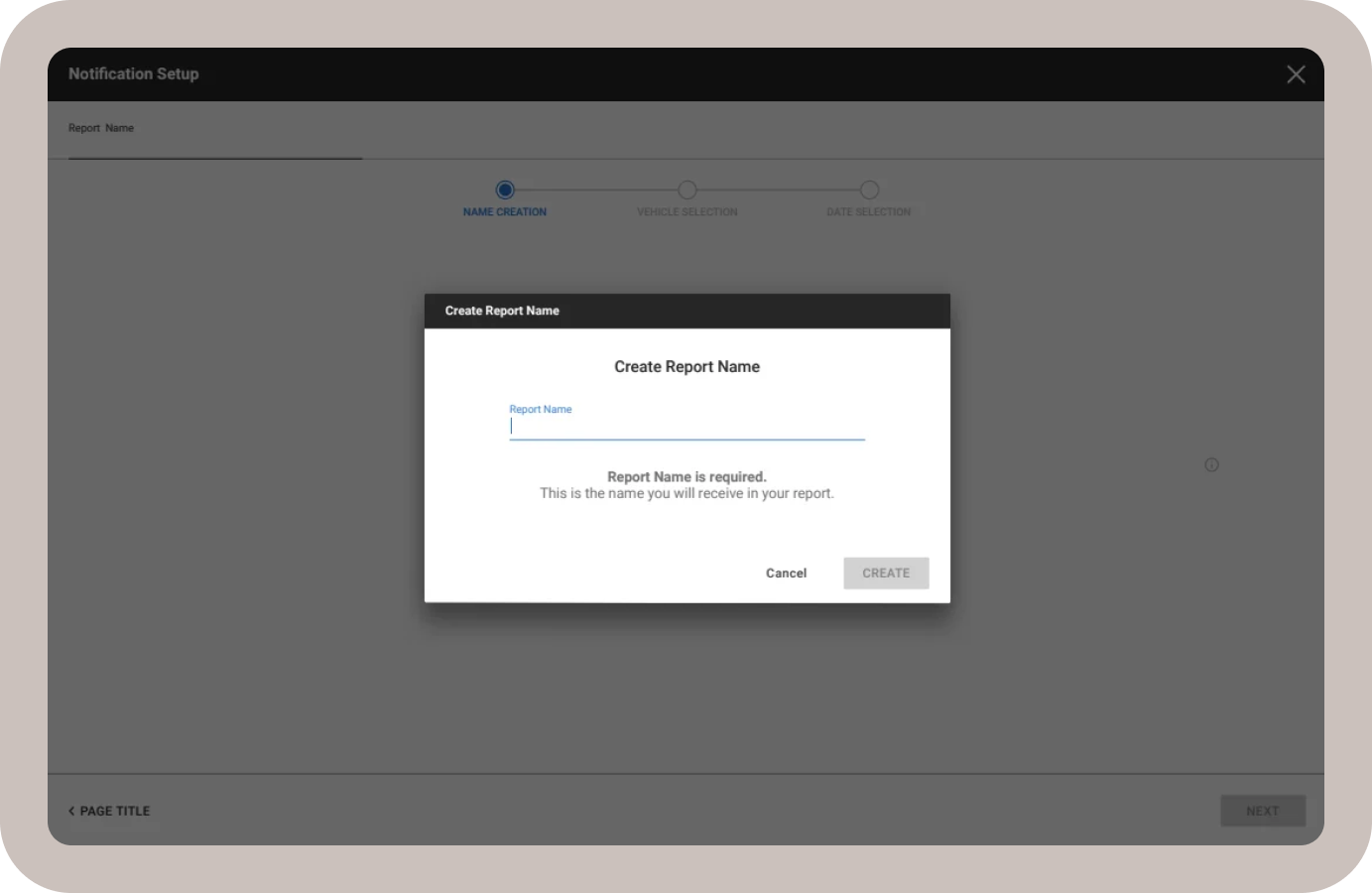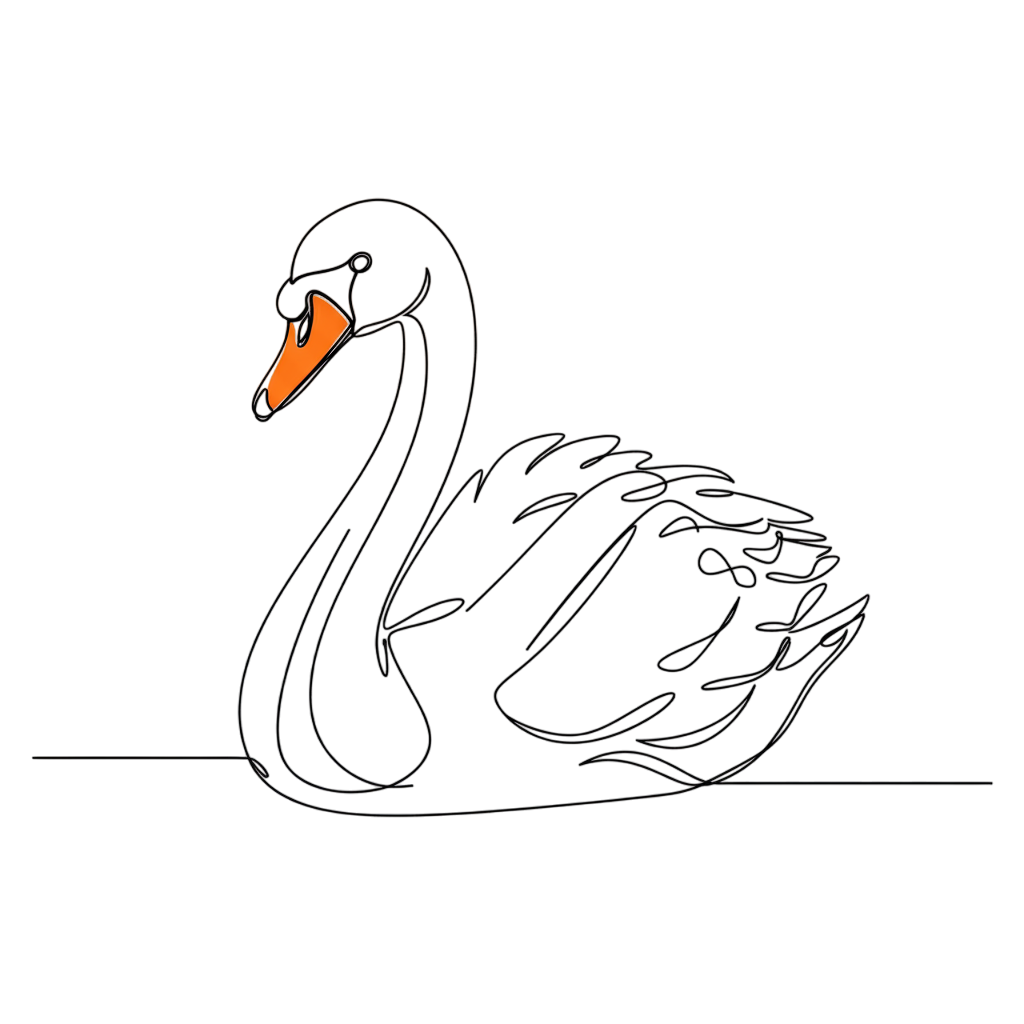
Driving Digital Growth in Agriculture
Summary
- My Role: Served as the sole UX/UI Designer for CNH Industrial’s digital agriculture offerings (CaseIH and New Holland). Oversaw design, handoff, and brand consistency for global product lines comprised of AFS/PLM Connect, Vehicle Management Systems, and Data Connect.
- Team: Worked closely with CNH’s global research department, developers, product managers, and marketing stakeholders—coordinating requirements, ensuring design fidelity, and maintaining alignment with corporate branding.
- Duration: 2019-2020.
- Overview: My role aimed to streamline digital experiences for farmers worldwide by improving user workflows and implementing consistent design standards. Through direct user research at farm machinery conferences, iterative design sessions, and cross-functional collaboration, we delivered cohesive, user-friendly interfaces across CNH Industrial’s suite of agricultural products.
Introduction
During my time at CNH Industrial, I was the primary UX/UI Designer for CaseIH and New Holland digital agriculture products. My focus was on improving user experiences across a variety of platforms, including AFS/PLM Connect, Vehicle Management Systems, and Data Connect. These tools enable farmers to monitor, manage, and optimize agricultural operations in real time—whether on the field or remotely from a desktop computer.
Key Contributions
- Owned the end-to-end UX/UI design process for multiple digital agriculture products.
- Collaborated with developers, product managers, and marketing teams to ensure consistency and quality.
- Conducted user research through surveys, interviews, and usability sessions at farm machinery conferences.
The Challenge
CNH Industrial, as a global leader in agricultural machinery, aims to continuously innovate their digital products. However, the agricultural tech space presents several unique challenges:
- Complex Workflows: Farming operations involve varied tasks—machinery setup, data management, field mapping, and more—all of which must be intuitively reflected in digital tools.
- Global Consistency: Branding, translations, and functionality must stay consistent across international markets and multiple user segments.
My mission was to design experiences that addressed these complexities while remaining user-friendly and efficient.
Design Approach
During my time at CNH Industrial, my duties spanned three primary categories: Research & Discovery, Design Management & Collaboration, and UX/UI Design. By structuring my work around these focal points, I was able to thoroughly understand user needs, effectively bridge the gap between designers and developers, and ultimately deliver engaging, user-centered solutions. Below is an overview of how each category shaped my process and informed the final outcomes.
Research & Discovery
I worked closely with CNH’s global research department to develop an in-depth understanding of farmers’ needs, workflows, and pain points. This involved conducting digital surveys, in-depth user interviews, and on-site usability sessions at farm machinery conferences. Observing farmers interact with prototypes in real-world contexts allowed me to gather both quantitative and qualitative feedback effectively.
Design Management & Collaboration
As the sole UX/UI designer for CNH’s agricultural digital products, I was responsible for translating design concepts into production-ready solutions. I collaborated closely with the development team to refine a detailed handoff process, ensuring each design was accurately implemented according to brand standards and functional requirements. Beyond working with developers, I partnered with marketing and digital operations teams to produce clear support documentation and release notes, helping users adopt new features smoothly. Additionally, I managed branding consistency and oversaw global translation efforts, so the suite of CNH digital tools would remain cohesive and accessible across different regions and user segments.
Product Design
My primary responsibilities involved designing cross-platform experiences to help farmers monitor and control their machinery efficiently, whether via mobile or desktop devices. In practice, this meant mapping user journeys, conducting competitor analyses, refining feature prioritization, designing intuitive interfaces, and applying CNH’s brand guidelines across various in-house brands. Key enhancements included overhauling dashboards for quick access to machinery status, field reports, and alerts; simplifying map interactions for real-time positioning and performance data; and unifying logins and settings across multiple CNH apps. By grounding every decision in user-centric design principles, I was able to reduce complexity and enhance overall usability for a globally distributed audience.
Designing Core Components
A major focus of the design phase was building atomic components that would form the foundation of the design system. These components were designed to be reusable, accessible, and scalable, ensuring consistency across ThinkMarkets’ platforms. I contributed directly by designing some of these components, each with defined states like hover, disabled, and active. Buttons were developed with primary, secondary, and tertiary styles to accommodate diverse use cases, while list components were created to support navigation and data presentation. By focusing on these foundational elements, the team delivered a cohesive system that streamlined workflows for both designers and developers. Below are some samples of high fidelity and wireframing screens.
Conclusion
Designing at CNH Industrial was a unique opportunity to tackle complex agricultural workflows while balancing user needs, branding requirements, and global reach. My responsibility spanned user research, design management, and hands-on UX/UI creation. By focusing on user-centric design, streamlined collaboration, and continuous iteration, we delivered tools that help farmers work more efficiently and effectively in their day-to-day operations—no matter where they are in the world.
Case Study Spotlight: AFS Connect Mobile Redesign
While my overall work at CNH covered multiple digital products, a standout example was the AFS Connect mobile app redesign. Below is a closer look at how we transformed a critical telematics tool for farmers into a more user-friendly and efficient solution.
Overview
When I began work on the AFS Connect mobile application, it existed in a pre-launch state. The platform was intended to help farmers track vehicle locations, engine hours, and maintenance schedules through GPS and cellular connectivity. However, the interface was incomplete and hadn’t kept pace with current best practices. Additionally, new features were on the horizon, and the design needed to be flexible enough to accommodate them. My goal was to modernize the user experience, align it with Case IH’s brand identity, and ensure it could meet the on-the-go demands of farming operations.
Pain Points & Objectives
Farmers required a centralized, intuitive experience that would provide real-time updates on machinery status, yet the old design contained unorganized crucial data and outdated patterns. Infromation was spread throughout different parts of the application. By addressing these shortcomings, I aimed to streamline fleet tracking and improve alerts, ensuring that the new AFS Connect app could truly serve as the single source of truth for farmers—anywhere and anytime.
Research & Discovery
Because the AFS Connect app was originally partially designed for a pre-launch iteration, I began by collaborating closely with our research department to revisit underlying assumptions and uncover additional user insights. Their data helped validate the necessity for robust maintenance tracking, particularly for farmers operating multiple fields. I also analyzed competitor apps in the telematics space to gain a broader perspective on best practices, UI patterns, and features that aligned with user needs. These combined efforts—internal research data, competitor analysis, and infromation from farmers—formed the foundation of the redesign strategy, ensuring that every design decision was backed by real-world requirements and industry-wide understanding.
Design Process
My first step was to review the existing design files to understand the original structure and ethos of the app. This allowed me to identify areas where the interface fell short of modern best practices and user expectations.
It quickly became clear to the team that farmers needed a concise summary page to immediately access high-priority alerts and gain an overview of their entire operation. This feature was crucial for farm managers overseeing multiple machines spread across different fields, as it enabled them to monitor equipment status and location at a glance. The summary page also allowed users to click into individual tractors for deeper insights into engine parameters, locations, and current statuses—a necessity for maintaining operational efficiency and avoiding downtime.
Leveraging insights from these analyses, I refined the information architecture to ensure critical data was surfaced at the right moments. I updated the iconography to align with CNH’s latest machine offerings and updated the color palette to maintain consistency with the desktop version of the app. This alignment ensured that both platforms shared the same visual language and organizational patterns, creating a seamless experience for users moving between devices.
The final design, as shown in the screenshots, features a clean, intuitive interface tailored to the needs of modern farmers. The Summary tab consolidates all active machine data, highlighting critical alerts and metrics such as fuel and DEF levels. The Fleet tab provides a list view with detailed statuses for each machine, while the Map tab enables users to track their equipment in real time across various fields. Lastly, individual machine pages allow for a deep dive into parameters, such as battery voltage, engine hours, and maintenance needs, ensuring that farmers have all the information they need to make timely decisions.
By blending the original design elements with fresh insights and a cohesive brand strategy, the updated AFS Connect app offered a streamlined, intuitive experience that caters to the real-world challenges of modern farming. This redesign became a cornerstone of CNH’s efforts to empower farm managers with the tools they need to optimize their operations efficiently, regardless of where they are.
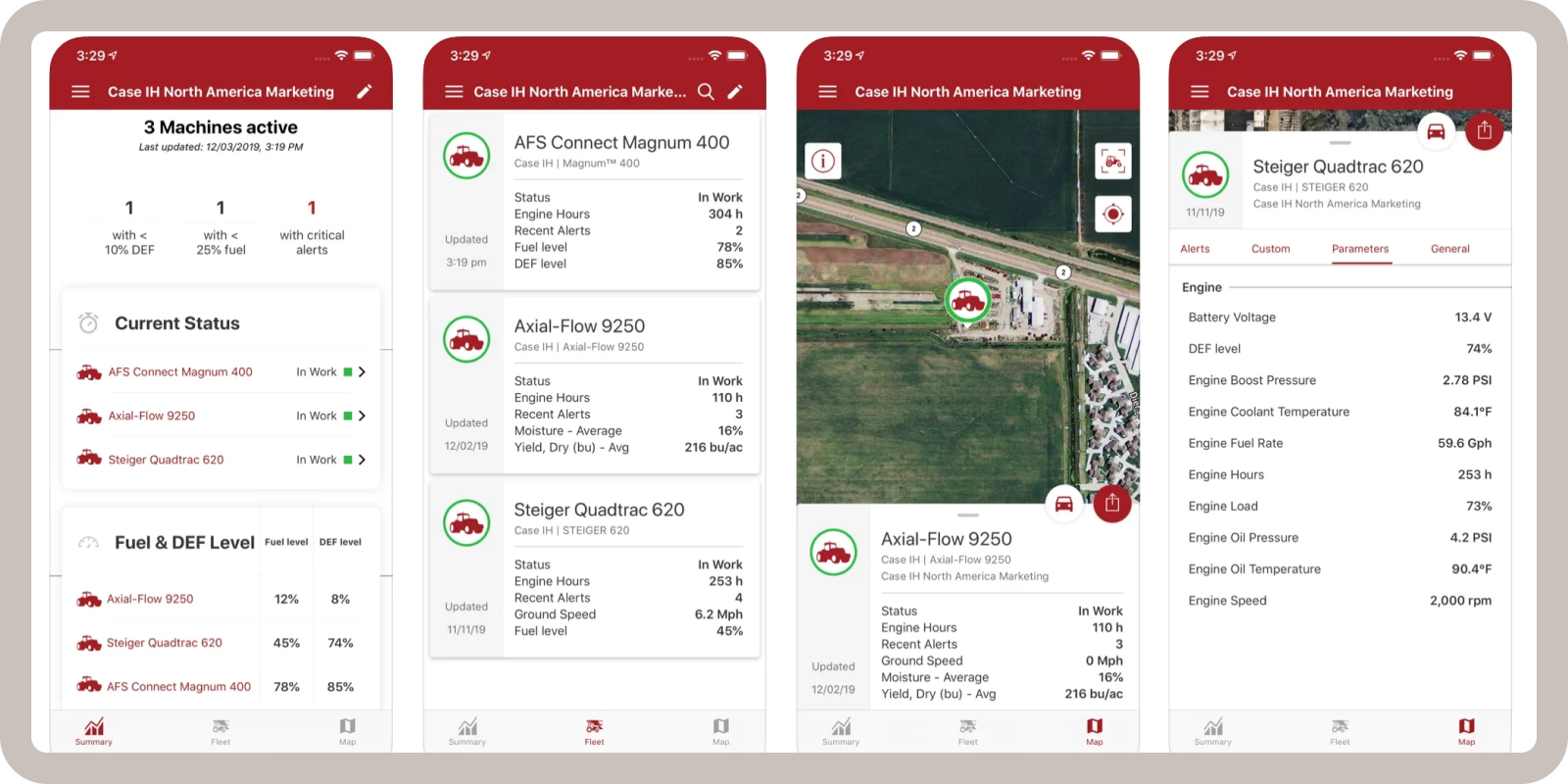
Stakeholder Collaboration
Working closely with a global development team based in Italy, I translated each design element into detailed specifications, ensuring a smooth handoff from design to code. Daily syncs allowed us to address technical constraints early and confirm that features were implemented correctly. Meanwhile, I coordinated with marketing and product management to synchronize branding elements, finalize app store requirements, and prepare release notes. This cross-functional effort was critical in meeting quality standards and avoiding surprises late in the development cycle.
Final Takeaway
By modernizing an outdated interface and adding essential features, the AFS Connect app evolved into a powerful telematics tool that meets the real-world demands of farming. The redesign illustrates how thoughtful collaboration, in-depth research, and flexible design can turn a promising yet underdeveloped product into a robust, future-ready solution that helps farmers maximize efficiency and reduce downtime across their fleets.
Selected Works
